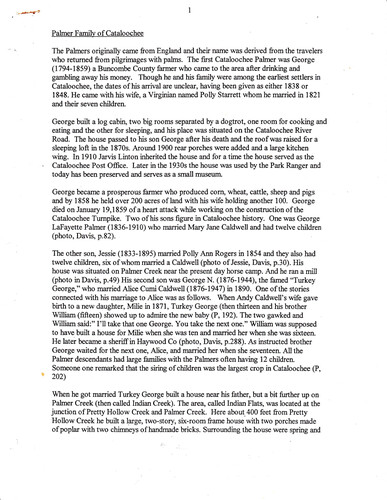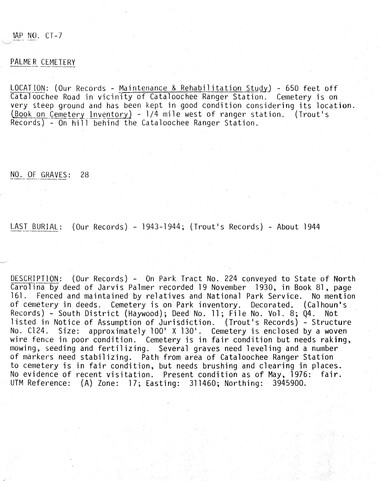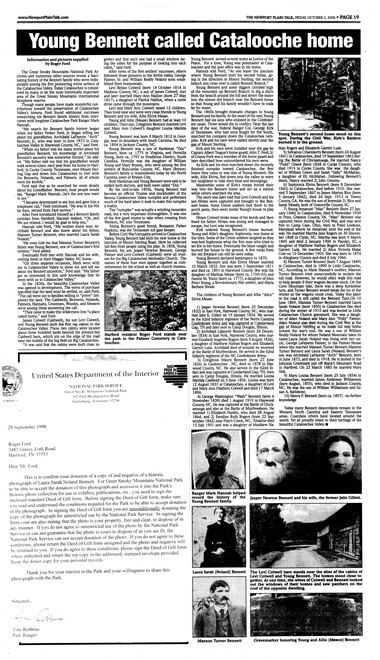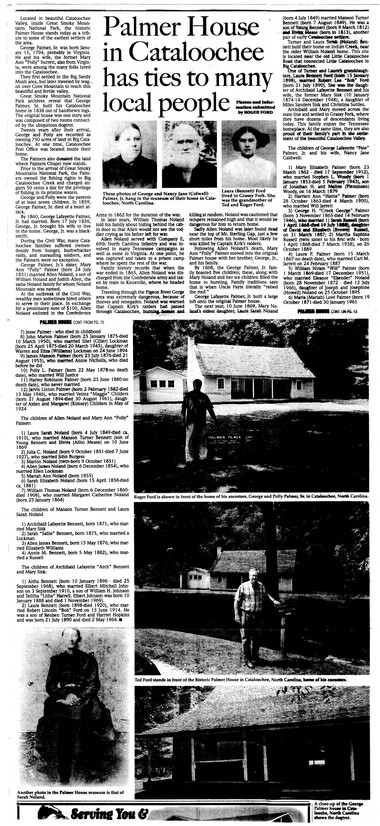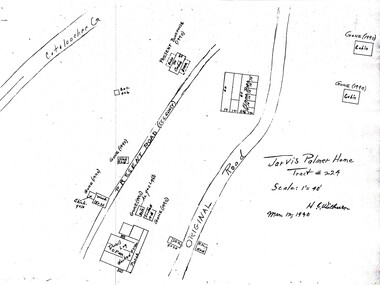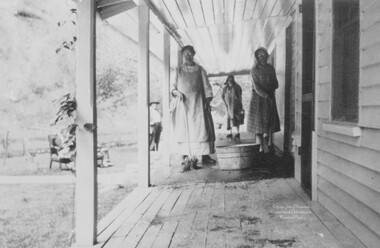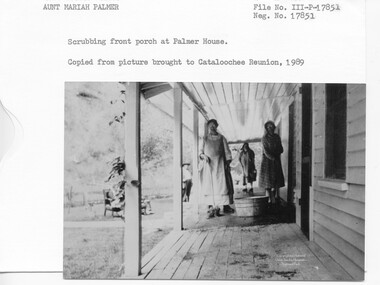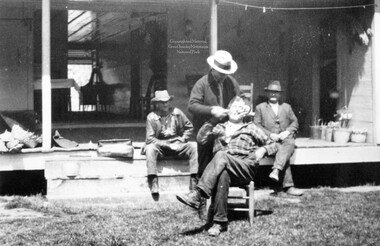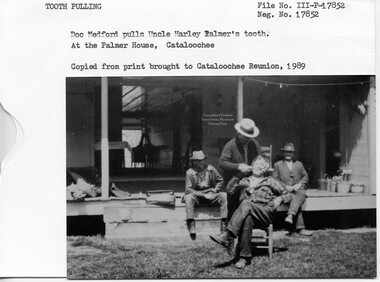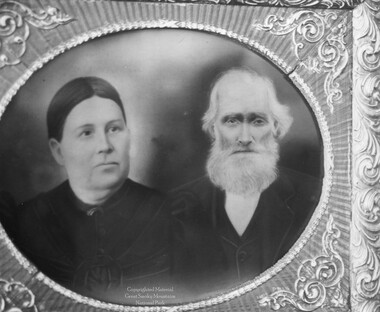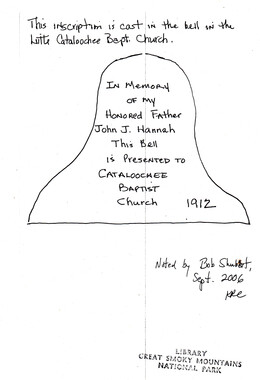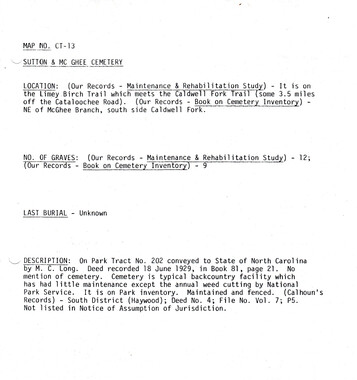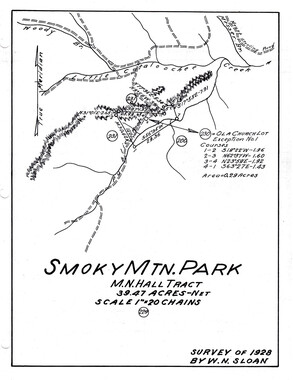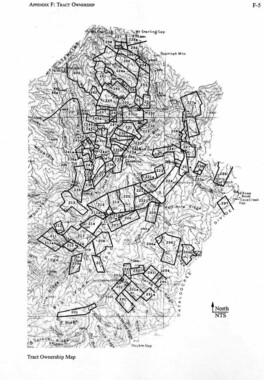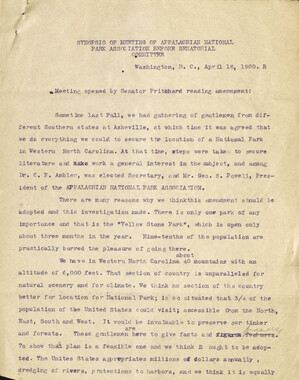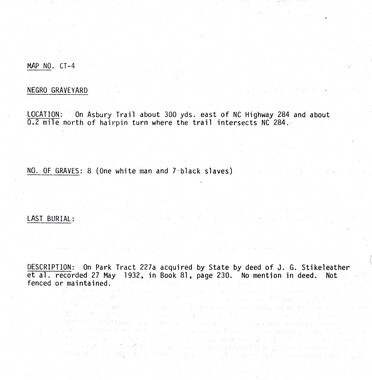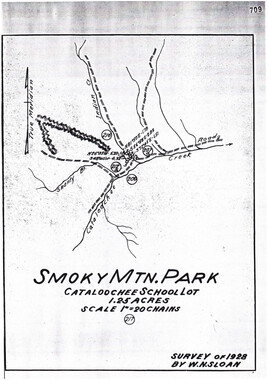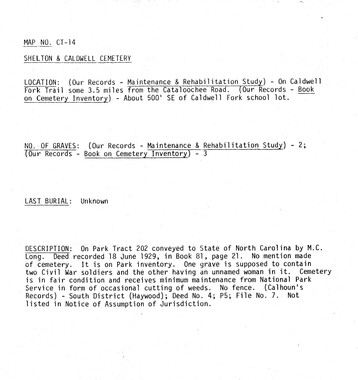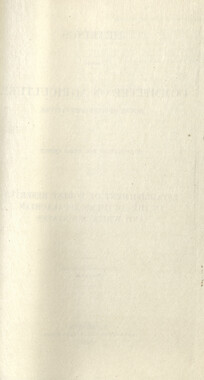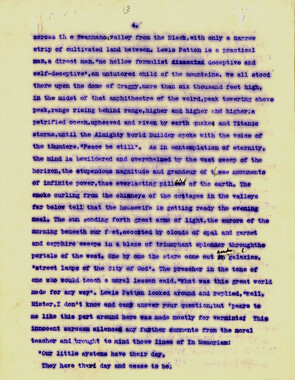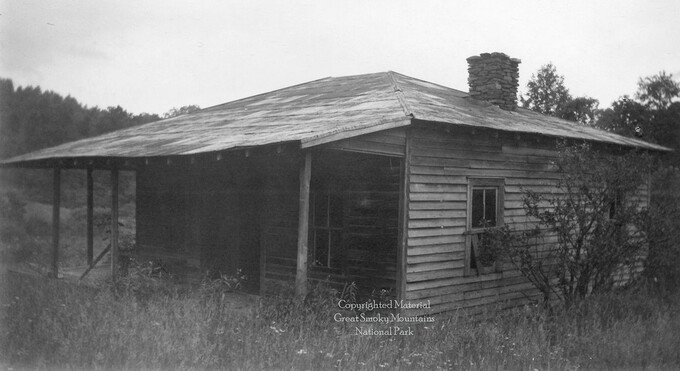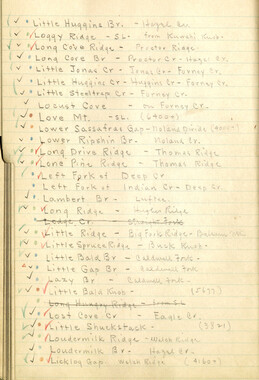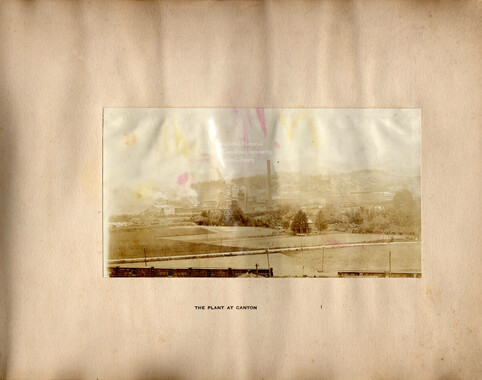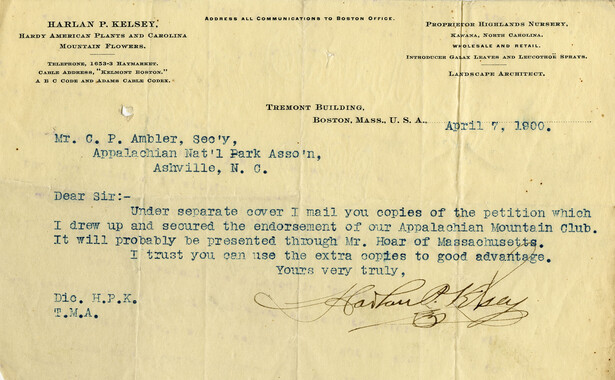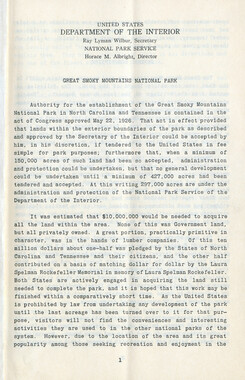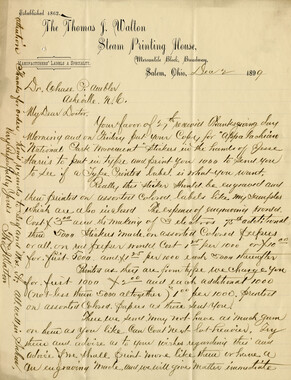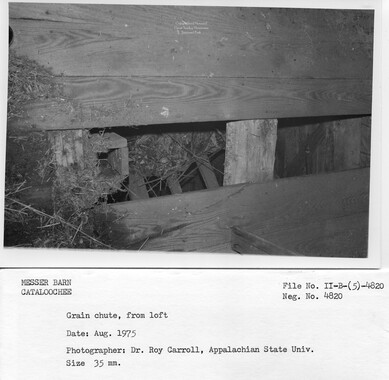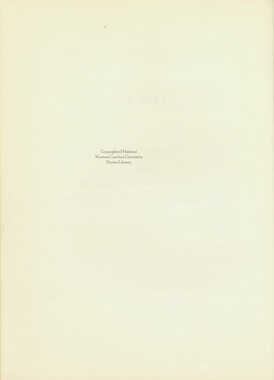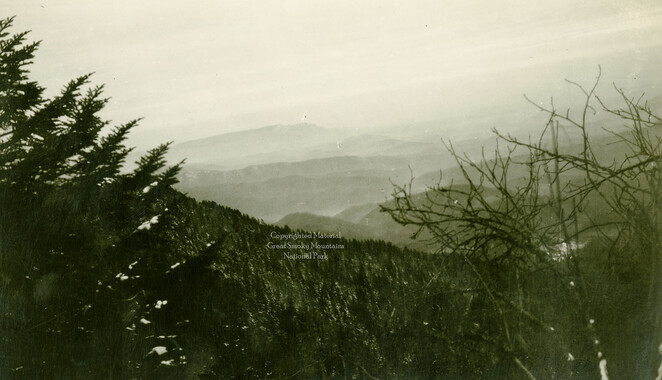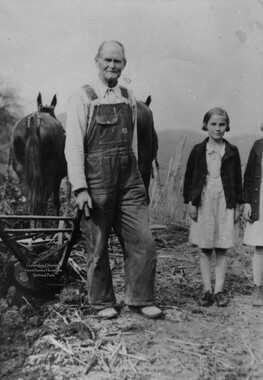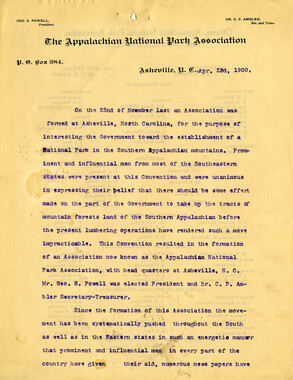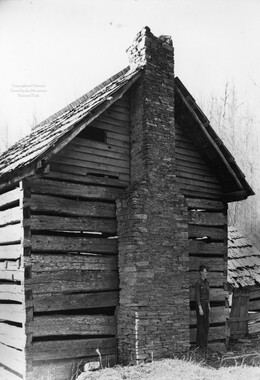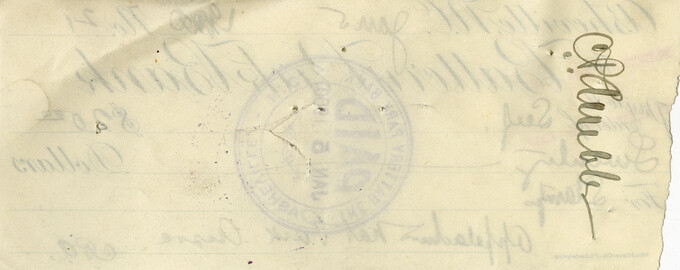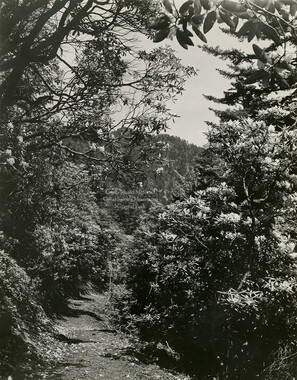Western Carolina University (20)
View all
- Canton Champion Fibre Company (2308)
- Cherokee Traditions (293)
- Civil War in Southern Appalachia (165)
- Craft Revival (1942)
- Great Smoky Mountains - A Park for America (2683)
- Highlights from Western Carolina University (430)
- Horace Kephart (941)
- Journeys Through Jackson (154)
- LGBTQIA+ Archive of Jackson County (15)
- Oral Histories of Western North Carolina (314)
- Picturing Appalachia (6679)
- Stories of Mountain Folk (413)
- Travel Western North Carolina (160)
- Western Carolina University Fine Art Museum Vitreograph Collection (129)
- Western Carolina University Herbarium (92)
- Western Carolina University: Making Memories (708)
- Western Carolina University Publications (2283)
- Western Carolina University Restricted Electronic Theses and Dissertations (146)
- Western North Carolina Regional Maps (71)
- World War II in Southern Appalachia (131)
University of North Carolina Asheville (6)
View all
- Allanstand Cottage Industries (62)
- Appalachian National Park Association (53)
- Bennett, Kelly, 1890-1974 (1295)
- Berry, Walter (76)
- Brasstown Carvers (40)
- Carver, George Washington, 1864?-1943 (26)
- Cathey, Joseph, 1803-1874 (1)
- Champion Fibre Company (233)
- Champion Paper and Fibre Company (297)
- Cherokee Indian Fair Association (16)
- Cherokee Language Program (22)
- Crowe, Amanda (40)
- Edmonston, Thomas Benton, 1842-1907 (7)
- Ensley, A. L. (Abraham Lincoln), 1865-1948 (275)
- Fromer, Irving Rhodes, 1913-1994 (70)
- George Butz (BFS 1907) (46)
- Goodrich, Frances Louisa (120)
- Grant, George Alexander, 1891-1964 (96)
- Heard, Marian Gladys (60)
- Kephart, Calvin, 1883-1969 (15)
- Kephart, Horace, 1862-1931 (313)
- Kephart, Laura, 1862-1954 (39)
- Laney, Gideon Thomas, 1889-1976 (439)
- Masa, George, 1881-1933 (61)
- McElhinney, William Julian, 1896-1953 (44)
- Niggli, Josephina, 1910-1983 (10)
- North Carolina Park Commission (105)
- Osborne, Kezia Stradley (9)
- Owens, Samuel Robert, 1918-1995 (11)
- Penland Weavers and Potters (36)
- Roberts, Vivienne (15)
- Roth, Albert, 1890-1974 (142)
- Schenck, Carl Alwin, 1868-1955 (1)
- Sherrill's Photography Studio (2565)
- Southern Highland Handicraft Guild (127)
- Southern Highlanders, Inc. (71)
- Stalcup, Jesse Bryson (46)
- Stearns, I. K. (213)
- Thompson, James Edward, 1880-1976 (226)
- United States. Indian Arts and Crafts Board (130)
- USFS (683)
- Vance, Zebulon Baird, 1830-1894 (1)
- Weaver, Zebulon, 1872-1948 (58)
- Western Carolina College (230)
- Western Carolina Teachers College (282)
- Western Carolina University (1794)
- Western Carolina University. Mountain Heritage Center (18)
- Whitman, Walt, 1819-1892 (10)
- Wilburn, Hiram Coleman, 1880-1967 (73)
- Williams, Isadora (3)
- Cain, Doreyl Ammons (0)
- Crittenden, Lorraine (0)
- Rhodes, Judy (0)
- Smith, Edward Clark (0)
- Appalachian Region, Southern (2393)
- Asheville (N.C.) (1886)
- Avery County (N.C.) (26)
- Blount County (Tenn.) (147)
- Buncombe County (N.C.) (1664)
- Cherokee County (N.C.) (283)
- Clay County (N.C.) (555)
- Graham County (N.C.) (233)
- Great Smoky Mountains National Park (N.C. and Tenn.) (478)
- Haywood County (N.C.) (3522)
- Henderson County (N.C.) (70)
- Jackson County (N.C.) (4692)
- Knox County (Tenn.) (21)
- Knoxville (Tenn.) (9)
- Lake Santeetlah (N.C.) (10)
- Macon County (N.C.) (420)
- Madison County (N.C.) (211)
- McDowell County (N.C.) (39)
- Mitchell County (N.C.) (132)
- Polk County (N.C.) (35)
- Qualla Boundary (981)
- Rutherford County (N.C.) (76)
- Swain County (N.C.) (2017)
- Transylvania County (N.C.) (247)
- Watauga County (N.C.) (12)
- Waynesville (N.C.) (68)
- Yancey County (N.C.) (72)
- Aerial Photographs (3)
- Aerial Views (60)
- Albums (books) (4)
- Articles (1)
- Artifacts (object Genre) (228)
- Biography (general Genre) (2)
- Cards (information Artifacts) (38)
- Clippings (information Artifacts) (191)
- Crafts (art Genres) (622)
- Depictions (visual Works) (21)
- Design Drawings (1)
- Drawings (visual Works) (184)
- Envelopes (73)
- Facsimiles (reproductions) (1)
- Fiction (general Genre) (4)
- Financial Records (12)
- Fliers (printed Matter) (67)
- Glass Plate Negatives (381)
- Guidebooks (2)
- Internegatives (10)
- Interviews (811)
- Land Surveys (102)
- Letters (correspondence) (1013)
- Manuscripts (documents) (619)
- Maps (documents) (159)
- Memorandums (25)
- Minutes (administrative Records) (59)
- Negatives (photographs) (5651)
- Newsletters (1285)
- Newspapers (2)
- Occupation Currency (1)
- Paintings (visual Works) (1)
- Pen And Ink Drawings (1)
- Periodicals (193)
- Personal Narratives (7)
- Photographs (12982)
- Plans (maps) (1)
- Poetry (5)
- Portraits (1655)
- Postcards (329)
- Programs (documents) (151)
- Publications (documents) (2237)
- Questionnaires (65)
- Scrapbooks (282)
- Sheet Music (1)
- Slides (photographs) (402)
- Sound Recordings (796)
- Specimens (92)
- Speeches (documents) (15)
- Tintypes (photographs) (8)
- Transcripts (322)
- Video Recordings (physical Artifacts) (23)
- Vitreographs (129)
- Text Messages (0)
- A.L. Ensley Collection (275)
- Appalachian Industrial School Records (7)
- Appalachian National Park Association Records (336)
- Axley-Meroney Collection (2)
- Bayard Wootten Photograph Collection (20)
- Bethel Rural Community Organization Collection (7)
- Blumer Collection (5)
- C.W. Slagle Collection (20)
- Canton Area Historical Museum (2110)
- Carlos C. Campbell Collection (198)
- Cataloochee History Project (65)
- Cherokee Studies Collection (4)
- Daisy Dame Photograph Album (5)
- Daniel Boone VI Collection (1)
- Doris Ulmann Photograph Collection (112)
- Elizabeth H. Lasley Collection (1)
- Elizabeth Woolworth Szold Fleharty Collection (4)
- Frank Fry Collection (95)
- George Masa Collection (173)
- Gideon Laney Collection (452)
- Hazel Scarborough Collection (2)
- Hiram C. Wilburn Papers (28)
- Historic Photographs Collection (236)
- Horace Kephart Collection (861)
- Humbard Collection (33)
- Hunter and Weaver Families Collection (1)
- I. D. Blumenthal Collection (4)
- Isadora Williams Collection (4)
- Jesse Bryson Stalcup Collection (47)
- Jim Thompson Collection (224)
- John B. Battle Collection (7)
- John C. Campbell Folk School Records (80)
- John Parris Collection (6)
- Judaculla Rock project (2)
- Kelly Bennett Collection (1314)
- Love Family Papers (11)
- Major Wiley Parris Civil War Letters (3)
- Map Collection (12)
- McFee-Misemer Civil War Letters (34)
- Mountain Heritage Center Collection (4)
- Norburn - Robertson - Thomson Families Collection (44)
- Pauline Hood Collection (7)
- Pre-Guild Collection (2)
- Qualla Arts and Crafts Mutual Collection (12)
- R.A. Romanes Collection (681)
- Rosser H. Taylor Collection (1)
- Samuel Robert Owens Collection (94)
- Sara Madison Collection (144)
- Sherrill Studio Photo Collection (2558)
- Smoky Mountains Hiking Club Collection (616)
- Stories of Mountain Folk - Radio Programs (374)
- The Reporter, Western Carolina University (510)
- Venoy and Elizabeth Reed Collection (16)
- WCU Gender and Sexuality Oral History Project (32)
- WCU Mountain Heritage Center Oral Histories (25)
- WCU Oral History Collection - Mountain People, Mountain Lives (71)
- WCU Students Newspapers Collection (1744)
- Western North Carolina Tomorrow Black Oral History Project (69)
- William Williams Stringfield Collection (2)
- Zebulon Weaver Collection (109)
- African Americans (388)
- Appalachian Trail (32)
- Artisans (521)
- Cherokee art (84)
- Cherokee artists -- North Carolina (10)
- Cherokee language (21)
- Cherokee pottery (101)
- Cherokee women (208)
- Church buildings (166)
- Civilian Conservation Corps (U.S.) (110)
- College student newspapers and periodicals (1830)
- Dams (94)
- Dance (1023)
- Education (222)
- Floods (60)
- Folk music (1015)
- Forced removal, 1813-1903 (2)
- Forest conservation (220)
- Forests and forestry (917)
- Gender nonconformity (4)
- Great Smoky Mountains National Park (N.C. and Tenn.) (154)
- Hunting (38)
- Landscape photography (10)
- Logging (103)
- Maps (84)
- Mines and mineral resources (8)
- North Carolina -- Maps (18)
- Paper industry (38)
- Postcards (255)
- Pottery (135)
- Railroad trains (69)
- Rural electrification -- North Carolina, Western (3)
- School integration -- Southern States (2)
- Segregation -- North Carolina, Western (5)
- Slavery (5)
- Sports (452)
- Storytelling (245)
- Waterfalls -- Great Smoky Mountains (N.C. and Tenn.) (66)
- Weaving -- Appalachian Region, Southern (280)
- Wood-carving -- Appalachian Region, Southern (328)
- World War, 1939-1945 (173)
Cataloochee tract 224: Jarvis L. Palmer
Item
Item’s are ‘child’ level descriptions to ‘parent’ objects, (e.g. one page of a whole book).
-
-
1 Palmer Family of Cataloochee The Palmers originally came from England and their name was derived from the travelers who returned from pilgrimages with pahns. The first Cataloochee Palmer was George (1794-1859) a Buncombe County farmer who came to the area after drinking and gambling away his money. Though he and his family were among the earliest settlers in Cataloochee, the dates ofhis arrival are unclear, having been given as either 1838 or 1848. He came with his wife, a Virginian named Polly Starrett whom he married in 1821 and their seven children. George built a log cabin, two big rooms separated by a dogtrot, one room for cooking and eating and the other for sleeping, and his place was situated on the Cataloochee River Road. The house passed to his son George after his death and the roof was raised for a sleeping loft in the 1870s. Around 1900 rear porches were added and a large kitchen wing. In 1910 Jarvis Linton inherited the house and for a time the house served as the Cataloochee Post Office. Later in the 1930s the house was used by the Park Ranger and today has been preserved and serves as a small museum. George became a prosperous farmer who produced corn, wheat, cattle, sheep and pigs and by 1858 he held over 200 acres of land with his wife holding another 100. George died on January 19,1859 of a heart attack while working on the construction of the Cataloochee Turnpike. Two ofhis sons figure in Cataloochee history. One was George LaFayette Palmer (1836-1910) who married Mary Jane Caldwell and had twelve children (photo, Davis, p.82). The other son, Jessie (1833-1895) married Polly Ann Rogers in 1854 and they also had twelve children, six of whom married a Caldwell (photo of Jessie, Davis, p.30). His house was situated on Palmer Creek near the present day horse camp. And he ran a mill (photo in Davis, p.49) His second son was George N. (1876-1944), the famed "Turkey George," who married Alice Cumi Caldwell (1876-1947) in 1890. One ofthe stories connected with his marriage to Alice was as follows. When Andy Caldwell's wife gave birth to a new daughter, Milie in 1871, Turkey George (then thirteen and his brother William (fifteen) showed up to admire the new baby (P, 192). The two gawked and William said:" I'll take that one George. You take the next one." William was supposed to have built a house for Milie when she was ten and married her when she was sixteen. He later became a sheriff in Haywood Co (photo, Davis, p.288). As instructed brother George waited for the next one, Alice, and married her when she seventeen. All the Palmer descendants had large families with the Palmers often having 12 children. Someone one remarked that the siring of children was the largest crop in Cataloochee (P, • 202) When he got married Turkey George built a house near his father, but a bit further up on Palmer Creek (then called Indian Creek). The area, called Indian Flats, was located at the junction of Pretty Hollow Creek and Palmer Creek. Here about. 400 feet from Pretty Hollow Creek he built a l~ge, two-story, six-room frame house with two porches made of poplar with two chimneys of handmade bricks. Surrounding the house were spring and 2 smoke houses, a barn and a chicken house (photo, Davis in Tour Guide, p. 16). They lived on the north side of Shanty Mountain, at the end ofBig Butt Mountain about400 or 500 feet from Pretty Hollow Creek near Indian Creek. Turkey George lived there until his death in 1944 and the house was then dismantled and moved to the Cove Creek area in 1945. In keeping with their family tradition of Uncle George and father Jesse, Turkey George fathered the usual Palmer number of twelve children, six boys and six girls; one of these was Robert Gudger Palmer, later nicknamed "Boogerman." Nicknames also seemed a characteristic Palmer trait. Another George Palmer was called "Creek George," while George N. acquired the nickname of Turkey George. Numerous stories relate to the origins of the Turkey George name and you can take your pick. The most fanciful account runs as follows: "George was walking on the mountain without a gun and, seeing a gang of wild turkeys, caught one as it fluttered along, barely managing to hold on to it by its legs. But as he did so, the turkey rose into the air and carried him across a gap to the next mountain where it dropped him." Thus his name. Another account has Turkey George out with his muzzle loading gun and only one bullet. He saw six turkeys sitting on one tree limb and he knew he had to have all six, but how was he going to kill them with just one bullet. Finally he fired one shot, split the limb and with the toes closed over the limb all six fell down, stunned, and he picked them up. A final account is told by "Turkey George," himself." I had a patch ofland in com. The wild turkeys was about to eat it up, so I built a pen to catch them. The pen was ten foot each way, and I covered over the top. Then I cut a ditch and rim it into the pen and covered the ditch with bark. I scattered com in the ditch so as to draw the turkeys into the pen. Next morning they was nine big gobblers inside and one outside. I stopped up the hole and got me a big stick to kill 'em with. When I got into the pen, they riz up and mighty nigh killed me instead; so I got out and fetched a hoe, When they stuck their heads betwixt the slats, I knocked them with it. ... That's why they call me 'Turkey George,' I reckon." He was not tall, but about 5' 8", wiry, all muscle and very strong. Weighed about 140. He wore a mustache. A Portrait of him at 18 shows him wearing a jacket piped with braid, waistcoat, a bowtie and a showy watch fob. But in later life would be seen mainly in red suspenders, baggy trousers, wool shirt, with no tie, coat fastened with safety pin, and an ever-present knapsack hung on his chest, and old soft felt hat. Around his hat his hair curled P 232). Had a horse called "Sank," which he never road, but walked beside him and had reputation of being able to out walk any person in valley. Would often walk to Waynesville and back, a 50-mile round trip. He also very much a taleteller and loved to spin yarns about his hunting exploits. He could also be quite witty and once remarked about a friend who had a hangover (P., 377): Your eyes looked like a red fox's ass in a pokeberry patch. 3 Cataloochee once had an abundance of wolves and deer and TG recalls two connected events (P., 461 and P., 465) They used to be wolves in these mountains. They came right down in the settlement and killed sheep. Like fox, they're too smart to be trapped, so I went to poisonin' them with strychnine. I put poisoned sheep meat in bushel baskets an' took 'em back in the mountains. I went back sometime later an' found two dead wolves. Turkey George's diary, now unfortunately lost, recorded twenty deer that he killed during his most active period as a hunter. Once the usually benign deer turned the tables on him, much as the turkeys had nearly done him in. In this instance, he and his brother. Will Palmer, were at a stand waiting for deer when a big buck ran up, jumped over his brother's head and, as he turned to get away, struck Turkey George with his buttocks and knocked him down, vanishing in the forest. The story goes that this was "the only time George acknowledged defeat at the heels of a deer. Another TG story (P., 470): Turkey George himself says that foxes were too smart to be trapped? Uncle Turkey apparently had his gun sight on everything that moved,. including squirrels, according to his son Robert as told to John Parris: "He was a mighty fine shot. As I say, he never wasted much lead or powder ... One time he was out hunting and killed nine squirrels without missing a shot. He shot offthe heads of six ofthern, and drew no blood from the other three." Also TG was reputed to have pulled out 365 rainbow trout in one day ( P., 487)-a record never surpassed. Flora recalls (P, 180): TG loved playing games with his dogs. Coming in from hunting he would sometimes run in the front door, his dogs after him, and race out the back, the whole pack following. Then we would run in the front again, in an endless circle. One could only imagine what his wife thought as they went through house, tracking in all the dirt. TG often went out to Lost Bottom over the top of Butt Mountain where there was also good fishing and a large grassy area without trees, which was good for cattle grazing ( P., 489) His greatest fame was in his having killed 106 bears before he died and he kept a journal of his bear kills, which unfortunately has now been lost. (P.203) He usually hunt alone using large steel traps, which he baited, and without hunting dogs. After a bear was killed TG would shout out cries of victory that could be heard for miles. And often he would jump on the dead bear, stand on carcass and shout for joy, yelling at the top of his lungs (P, 203). Once after a bear was shot and down, he jumped on him and put his hands on the bear's throat to shut off circulation and hasten the death. He loved to tell tall tales or give account of the bears he had killed. He killed most of them after they have been trapped in pens, or caught in steel traps. He didn't own bear dogs. Most likely he set his traps on Big Butt Mountain between Beech Creek and Pretty Hollow 'Creek ... that was Turkey George's favorite trappin' ground. He had one trap that he called his 'Grizzly Trap'. It weighed about eighty pounds. And he had others that weighed about fifty pounds each. But he was a great hunter. And he trapped bears in the 4 fall of the year when they were fat ... and then after they would go to den and come out, he would trap them again. So he had two trappin' seasons ... and bear meat about all the tine, I guess. He was a great hunter and trapper. Uncle Turkey said that ifbears have plenty to eat all fall, they'll hibernate real early. Once he went up Beech Ridge and scared a bear out of hibernation. It had made a tepee out of branches, with leaves over it. This was in May. They don't hibernate long any more because there's not enough food or mast (P, 233) John Parris talked to Turkey George's son, Robert Boo german one Sunday and wrote the following (P, 234-5): My father had a reputation for bein' a mighty hunter. He hunted all the time. He knew every foot of-these mountains. And he sure crave the wild turkeys and the bear a fit. That is, until the Government came in and took our land and run us out." "Why, before he had to hang up his rifle, he had killed off 106 bear one way or another. Some of them he trapped. And one he killed with a pistol. My Mother always could tell before my father ever got to the house whether he had got a bear. When my father got to Butt Mountain·-- that was just off above the home place between here and Pretty Hollow Creek -- he would let out a powerful yell. When he done that, my mother knew to get the water boil directly. Back then a fellow had to be mighty saving with his shot and powder. It was hard to come by, and hunters like my father didn't squander it. They made every shot count. He run his own bullets and he could still chew his own lead right up to the end of his hunting days .... Most of his hunting was done with a hoc-rifle, a muzzle-loader. But when he was getting along in years, he bought himself a 38 Winchester. Got it down in Waynesville. It was after dark when he got back home and he was so proud of that rifle he thought he would have himself some fun. When he got close to the house, he hauled off and fired his rifle into the air and let out a big whoop. As it happened, his father-in-law, Andy Caldwell, was there at the house, and he was sittin' a close to the front window. Well, when that rifle went off the windowpane fell out and broke all over the place. Don't know what caused it to fall out just at that- minute. Anyway? Andy thought for sure he was shot. He jumped up and yelled that he was shot. My father heard the commotion and come on into the house. They looked Andy over and couldn't find a drop of blood, They finally convinced him he hadn't been shot and then my father told him about firing his rifle into the air. He told them he had fired it into the air. But I don't think Andy ever believed it. I think he always thought my father put a bullet right through that window." Poor old gun-shy Uncle Andy- often the victim, but never shot! Joe Hall recorded Uncle Turkey's Cousin Will one September day in 1939, who told, in typical cousinly fashion of one time when Turkey's gun failed him. Me and him (Turkey) decided to go down to the traps one day. Got a big bear in the trap. And we come off down to the open woods and we had to step across a little swampy dreen. So we just go on to the trap ... Bear-trap was hung over a laurel stump by the grabs. George raised up with his Winchester to fire, and he never touched a hair on that bear. I said, George, help yourself again to a shot with mine and kill him. So George ~teadied hisself agin a saplin'and just busted that bear's head open. So we dressed the bear and carried him in home. 5 On another occasion: (P., 285) Turkey George Pahner recounted events from his hograising days. Back then (in March of 1919); Turkey George raised his hogs out in the mountains. Let them run loose to fleshen up on acorns and chestnuts. Once he was out in the hills looking after his hogs when he ran upon a sight that fairly set him boiling. He could read signs and knew what had happened right away. There before him were the bloody remains of eight pigs. A bloody trail led off through the woods. Turkey George read the sign and knew a bear had killed the pigs and the sow and carried off the sow to feast on later. So he hurried home, got his bear trap, and carne back. He took up the trail and found where the bear had dragged the sow to the sunken place in the ground and pulled there And when he carne back a couple of days later, there was the bear in the trap . . . a whopping big one of 526 pounds. Sometimes even Turkey George got bested. (P., 274): They tell the story on Uncle Turkey George. He had married Uncle Andy Caldwell's daughter. Aunt Alice. At this com shuckin' they'd come to a good ear of com that would make good seed com - well. Uncle Turkey would just lay it out. He had enough seed eom picked out for his crop of com the next year. Of course, after they had the com all shucked and cleaned and everything, my Uncle Andy, he's a pretty tight old fellow; he didn't want his son-in-law to even have that com. And when he cone to it, he just throwed it right back into the crib with the other. Said Uncle Turkey didn't speak to his father-in-law for over a year. Turkey George figures in many other exploits and legends about the Valley. Perhaps the most famous is the story ofthe burning of schoolhouse in Big Cataloochee (P, 144-5, Davis, 126). Built in .... the old schoolhouse had become too small and as early as 1893 Big Cataloochee had petitioned for a new one but were repeatedly turned down. Finally three men (names vary, but it seemed to be Steve Woody, George Caldwell, Turkey George and Hiram Caldwell came to Waynesville to get some money from the county commissioners. All they needed was enough to pay the carpenters and get some paint. But the commissioners said, 'Sorry we can't do that . . we don't have any money and you don't pay enough taxes over there ... no chance of getting a new schoolhouse.'" These men had told the folks at Cataloochee that they were going to Waynesville to get a schoolhouse and they were mighty disappointed. There was a dispensary across from the courthouse at that time and they went over and got a pint of whiskey. They had brought their lunch with them so, going back, they stopped to eat and drink the whiskey. They dreaded telling the people that they couldn't have a new school. So they rode on back to Cataloochee and it was dark when they got there. They rode by the old school and stopped to look at it. One of them said, 'I'll tell you what we'll do, we'll bum'er down.'" Then they went in the school and took out all the tables and little sweaters and some dinner buckets the children had left and they got the books and the blackboard. They cGvered the other things up with the blackboard in case it rained." "Then they struck a match and set fire to the building and when it was burning pretty good, they got on their horses and rode off. It looked like the whole world was on fire." 6 They shook hands and agreed never to tell what they had done until only one was left alive. But they soon got the money for the new schoolhouse. Even in his death Turkey George was different. Contrary to usual custom, he wanted a steel casket, not the traditional wooden one. Evidently he wanted to make sure that bears did not dig his grave up in revenge for all their numbers that he killed. (P, 117) Flora Palmer. Turkey's third child (B. 1894) recalled growing up in his household, her daily chores and memories of going to school (P, 147-8): After getting up before daylight in order to get her chores done, she would walk one and a half miles to school where they gathered around the big wood stove on winter days. She remembered the homemade shingles or shakes of the old schoolhouse. Eight-thirty was when school began. Ten-fifteen was recess with time out for Tap Hand, Base, Town Ball, Drop the Handkerchief or any of the other childhood games. Lunch was at twelve o'clock. Most children carried an Indian basket, which often held a glass of molasses and butter, sometimes biscuits, sometimes green beans, cukes, tomatoes, or corn, an apple, or blackberry pie, ham, though meat was not always included, and sweet potatoes. Heavier fare than the skimpy peanut butter and jelly sandwiches oftoday. The children used slates and rags and chalk for writing in Flora's day. Spelling, reading, arithmetic, geography, and history were the only subjects that were taught, of which history was Flora's favorite because she could remember dates. Verlin Campbell was Flora's first schoolteacher. He once hit her head with a pencil . . the only punishment she could ever remember receiving. Actually, Flora, to her great embarrassment, was teacher's pet. Verlin was a big rough, gruff fellow, and used to carry her around on his shoulder while she would beat him and pull his hair. Aside from a fifteen-minute recess in the afternoon, school stopped at four o'clock, at which time all the children all went home for their evening chores. Flora later became a teacher in the school herself and taught many members of her own family, including Robert Flora's Recollections of work: (P. 198-199). Women's work was cut out for them at birth. Even the youngest girls had a tremendous load upon them Witness atypical day in the life of little Flora Palmer in the early part of this century: This little girl's chores included milking, hoeing corn, and going with a couple of her brothers and sisters to find the free-ranging lead cow with the bell in the evening. She also cooked, carried spring water, chopped stove wood, pulled fodder, cut tops, tied fodder, made hay stacks, helped with molasses-making, and got saw briers out ofthe cradled oats. Not an unusual day when she was a school girl was one during which she got up before daylight, helped make breakfast, washed the dishes, milked the cows, strained the milk, churned, and washed clothes in the wash pot before going offto school in her calico dress." Boil'em with lye soap; Would eat your hands!" If Flora went to school on horseback, she wouldn't ride sidesaddle, but went astride, as did most practical Cataloochee girls. But usually she walked, by eight o'clock, one and a 7 half miles to the school with its rived shake roo£ On cold winter days they would gather round the big wood stove when they first arrived. School ended at four o'clock. And Flora headed home to pick beans, dig 'taters, get the cows in, gather stove wood, dig ramps, or pick blackberries in season. There was always a pot of cornfield beans with bacon cooking on the stove when the children came in, and big pitchers of sweet milk on the table from the springhouse. After supper, when she had washed the dishes and done her lessons, she was allowed to read the "Comfort" papers, or Turkey George would tell bear tales to his children. Sometimes her mother would sing hymns while they quilted for the beds, later pulling up the quilting frame to the ceiling at the end of the evening. Some evenings Flora carded and spun wool, but did no weaving, as they sold the wool and bought Iinsey cloth with the money. There were no idle hands for the Devil's work in Turkey George's family, especially for little girls like Flora. Her recollections ofXmas: ( P, 163): "Oh, we'd find an orange and pretty apple and some stick candy. That's about all. Well, Anyhow Pop and Mom, they'd get up and slip in the house, y' know. Then after we went to bed, they'd distribute it around. It was a long time we didn't know that there was no Santa Claus. And I was kinda disappointed when I found out it wasn't." On Thanksgiving the Palmer family did not have turkey, but did have an extra dinner and had friends in. Usually they had a baked hen and this was the time for the traditional bear hunt. Flora's recollections of medicines and herbs used: (P, 255-6) In the medicine line, we had catnip and pennyroyal (sometimes pronounced 'pennyrile'). That pennyroyal, we used to pull it up; it grows 'bout this high. You see it? Smells good. And we used to dry it, y'know, hang it up and tie it and dry it so we'd have it in the wintertime to take when we had colds. We'd make it into a tea And then we had catnip. I think they gave that to babies mostly. Now we didn't drink those at the table. Now, catnip, pennyroyal, what else did we have? Mullein! Yeah. Now that's something not good at all .. .it was something about colds. I don't know what. I'd rather be sick than try to drink that. Well, there's more than that, but now that pennyroyal and catnip was really good, especially that penny-royal, put a little sugar in it: Brew catnip teas in water and drink for colds (I think this was for babies. Penneroyal tea. Good for adults to drink for colds. Mullen tea. Plants grow tall and have large fuzzy leaves. Make tea for tonic in spring of year. Boneset tea. A spring tonic. It grew in and around Groundhog grease: render groundhog fat. Strain and put in jar. It's used on chest for colds. Grease chest with grease and cover chest with wool flannel cloth that has been greased on one side and a few drops of turpentine dropped on it spread on chest and cover patient up to keep warm. Also rub some grease on throat and give one halfteaspoon grease to swallow. Bear grease was used for same thing. Groundhog grease was more plentiful. Therefore was used more. Spring tonic: one teacup of molasses, three tablespoons sulphur. Stir and take some for ~g tonic. Make poultice of wheat bran by cooking bran in water few minutes cool and ...-e~ _aJayer on cloth and apply to sores boils etc to draw out the inflammation and pus. 8 Horse oats boiled in water. Drain off water and bathe affected parts for poison oak. Moisten tobacco leaf in water and place over boil and tie clothe on to draw out pus. If fever causes tobacco leaf to dry moisten it again and keep on sore for longer time. Worm medicine: Get seeds off Jerusely-moke (Jerusalem Oak) plant in fall put handful of seeds in pint of molasses on stove and bring to boil, when cool let child eat several spoon-full once or twice and the worms will be gotten rid o£ Preventive of diseases: tie small ball or wad of assidifidy- (asafoetida) in rag: tie with string around neck. Flora's recollection ofhog hide tanning: (P.,315): A recipe written down by the late Flora Palmer tells of the ways some things in the valley could be utilized with-out going to the store or ordering from the catalogue: To tan ground hog hide for leather, take fresh skin and trim off all excess fat. Put in trough that has been chopped out of a piece oflog. Put hickory ashes, about one half gallon water to cover hide, and put hide in, hair and all. Weight it down a little so none will be above the water. Lay plank or something over trough to keep animals out and let stay several days. Notice when hair will slip off, then put in branch and wash good till all hair is removed. Let soak in branch two days. Weight it down in water so as not to wash away. Rub and squeeze it good. Stretch it out and tack (to a) plank and set aside to dry. After it's dry, take down and work and stretch it in hands. It should be soft as cotton rag. Cut shoestrings off length of hide as needed. Strings could be used to patch harness. Flora's account of foods and preparation (P.,352-3): Had spicewood tea, they called it. And we'd drink that at table. And sassafras tea. But I never liked that. That spicewood I thought'us real good. My grandmother said, though, that the reason we didn't use no more ofthat sassafras was that the kind they had on Jonathan Creek didn't grow over there. Anyhow, we had the kind that didn't make good tea. Spicewood, sticks of a tree, y'know, little limbs. It grows sorta in moist places. We used to, when I can first remember, we'd sweeter it with. molasses, homemade molasses. And then we got so we didn't have homemade molasses all the time, so we put sugar in it. But it was really good with that homemade molasses. Pumpkin butter ... well, you must peel that and cut it up like you would apples and cook it a long time. And way back yonder they'd sweeter, it with molasses. And later on they got to sweetenin' it with sugar, and put it in these big ole iron vats that they used to boil their Clothes in out in the yard. Put some sticks under it and get your far (fire). You can't have too much far; that's why it takes so long to cook. But it's good and they flavor it with spices. I think sallet peas is one of the best vegetables in the world. We always grew some and made enough to can, always canned some if we could. They' re as good as canned beans. They're edible pods. Some think you have to pick 'em real early before their maturity, y'know. But these edible peas, they're not too particular. We always kept a lot of kraut on hand. In big crocks ... a long time ago. And then we got so we'd just can it up and keep it in jars ... in half-gallon jars. 9 We didn't go in for bear lettuce that much. It's tough. Don't you think it's fuzzy or somethin? But I like 'kilt sallet'. To make that you put onions and hot bacon grease on the greens, and s little vinegar or. the greens. Rhubarb pie's the best pie you ever ate! We didn't use to eat poke greens, but I eat it now when I can get it. It's as good as spinach. Have you eaten any? Mushrooms! We' us always afraid to ... you have to know what you're do in' there, they tell me. And lots of people won't eat poke sallet because ... well, I say this, if you don't get down in that root, you don't get the poison. That's what I've read, And I know you don't because I have eaten tops and cooked wild poke sallet. And I think it's good for you! Big Hominy's the whole grain, com, the kernel. We had grits, too. Boil grits a lot longer than we do now, and they're the best thing. We never cook 'em long enough now. Back then they cooked them a long time. Cracklin' bread, that's good. Have you ever had any of it? We don't ever have no cracklin's anymore "cause don't have no hogs. Sweet potato pie's good .. and blackberry cobbler. Her Marriage (P.,194). Marriages and funerals not usually held in church. Flora went to Greenville, South Carolina and married in parsonage. Had to wait three days in NC after you applied for a license, so they went there, got married and spent some time and then came home. No money to be spent on wedding. Eva Palmer, TG's oldest daughter (B.1891) dated a Caldwell, Marion Hubert. TG did not care for the match, so she married w/o his permission. The marriage was unlucky and the girl died soon after of a ruptured appendix. Doctor came but could only look on helplessly. (P, 263) Nellie Palmer, TG's second child (b.1893) won a local beauty contest as a child and as a result the fourth post Office in Big Cataloochee was named after her (Davis, 174). The PO was near the chapel and located in one part of a store run by Maria Palmer Ida Palmer, TG.'s 8th child (b.l902) was considered one of the prettiest girls in T. G's family. Robert Gudger Palmer was TG's youngest son and like many of the Palmers, Robert G. went by the nickname, Boo german. There are two versions of how he got this nickname. The most quoted story is as follows: Going to school could be a frightening experience for smaller children who had been sheltered in large families like Turkey George's. Young Robert Palmer was so frightened on his first day of school that when the teacher asked his name, he put his head down on the desk and said the first thing that came to his mind: "Boogerman." Another story relates that a teacher asked Robert Palmer what he wanted to be when he grew up, he answered: "I want to be a boo german." Surprised the teacher then asked if he didn't want to be something else beside a boogerman. Robert replied again. ''No that's what I want to be." At any rate the nickname stuck. 10 When he grew up, he established a farm in the Caldwell Fork area, a mile or so up in a somewhat deserted area. He built his own trail of about a mile and Y2 to reach his home. On his land he had a large two-story frame house, a barn, a can-house, and a springhouse. He refused to let his land be cut and so it still has some of the largest trees remaining in the Cataloochee area. He was noted for his hard drinking, being "awful bad to drink' (P., 83 ). A friend records that when she was visiting there one the Intemal Revenue Officers came to his house, searched all around, took names, but found nothing (P, 77) 73~~~ ~~ 6porj2'-LJ r--cf.e.. CA.A Kjj r e t1 F7 A/(! ;, ~7s~~ ~~ <j---'/J-br ]...:)..?'{ ~#U;j«Jl~)
Object
Object’s are ‘parent’ level descriptions to ‘children’ items, (e.g. a book with pages).
-
The 559 acres in Cataloochee tracts 224 and 224a were owned by Jarvis L. Palmer. The Palmer House is among the few preserved structures that remain today in Big Cataloochee. While, in general, the Great Smoky Mountains region was sparsely populated, the Cataloochee Valley remained an exception. By 1900, the population of Cataloochee had grown to 1,000 residents living in hundreds of log and frame homes. A few historic buildings have been preserved on site, including two churches, a school, several homes, and outbuildings. The North Carolina Park Commission was tasked with purchasing land for the Great Smoky Mountains National Park and people living in Cataloochee were among those displaced. Cataloochee families continue to return for annual reunions. In 2001, the National Park Service re-introduced elk into the valley.
-
